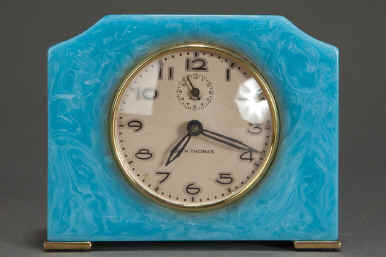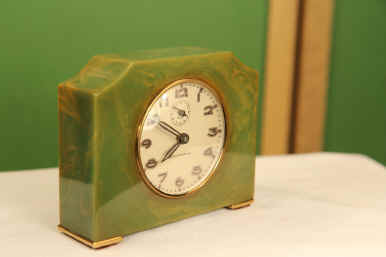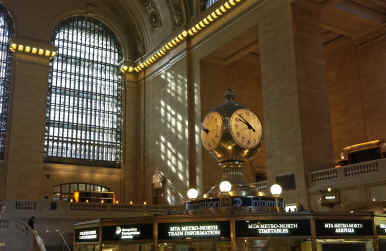|
THE CLOCKMAKER OF PLYMOUTH HOLLOW
 Seth Thomas was born in Wolcott, Connecticut, in
1785. At the age of 14 he began apprenticing with Daniel Tuttle, who
owned a joinery business, and worked building houses and barns. Seth Thomas was born in Wolcott, Connecticut, in
1785. At the age of 14 he began apprenticing with Daniel Tuttle, who
owned a joinery business, and worked building houses and barns.
After apprenticing for several years Seth began
looking for another, greater opportunity. He found this is clock making.
In 1807, he started working for clockmaker Eli Terry. He spent the next
several years learning the business of making clocks while working as a
carpenter. Their largest project during this apprenticeship was the
production of 4,000 wooden clock movements using Eli Whitney’s method
of making standardized parts. After several years of instruction he
formed a clock-making partnership in Plymouth, Connecticut with Eli
Terry and Silas Hoadley, a young clockmaker who also worked on the
wooden movements, as Terry, Thomas & Hoadley.
In 1810, he and Silas Hoadley bought the business
from Eli Terry, making tall clocks with wooden movements. In 1813, Silas
bought our Seth’s interest. Seth moved to Plymouth Hollow,
Connecticut, where he set up a factory to make metal-movement clocks. In
1817, he added shelf and mantel clocks. These were cased in pillar and
scroll cases until 1830, when the bronze looking glass and other styles
became popular. In 1842, brass movements were introduced, and first
cased in the popular O.G. case (which was made until 1913). Wood
movements were phased out in 1845. In 1853 Mr. Thomas incorporated the
Seth Thomas Clock Company, so that the business would outlive him. Mr.
Thomas died in 1859, and Plymouth Hollow was renamed Thomaston in his
honor in 1865.
 Though an innovator when it came to production
techniques and business, Thomas was rather conservative when it came to
the appearance of his clocks. So, after his death, Thomas' sons were
quick to introduce new clock styles, from handsome wall clocks to
regulators to spring-driven clocks to clocks with calendars. Though an innovator when it came to production
techniques and business, Thomas was rather conservative when it came to
the appearance of his clocks. So, after his death, Thomas' sons were
quick to introduce new clock styles, from handsome wall clocks to
regulators to spring-driven clocks to clocks with calendars.
Of the calendar clocks, the Seth Thomas antique wall
clocks for kitchens were particularly popular. One early double-dial
calendar clock made shortly after the founders’ death had a
rosewood-veneer case that came to points at the top and bottom to earn
itself the nickname of "Peanut." Walnut kitchen clocks were
produced from 1884 to 1909.
One of the toughest competitors for U.S. clockmakers
in the second half of the 19th century were the French, whose clocks
cased in onyx and marble were all the rage. In response, U. S.
manufacturers made clocks that resembled those of the French, except
instead of marble, they made their cases from less expensive iron or
wood.
Thomas responded to the French challenge with its own
line of marble clocks (1887 to 1895) and iron clocks finished in black
enamel (1892 to 1895). But the Thomas response that is best known today
was its Adamantine black mantel clock, which debuted in 1892.
 Adamantine was a veneer developed by the Celluloid
Manufacturing Company. Thomas licensed the veneer because it could be
produced in black, white, and a variety of patterns to replicate the
look of wood, onyx, and, most importantly, marble. The Seth Thomas
Adamantine mantel clocks were popular enough to remain in production
until 1917. Adamantine was a veneer developed by the Celluloid
Manufacturing Company. Thomas licensed the veneer because it could be
produced in black, white, and a variety of patterns to replicate the
look of wood, onyx, and, most importantly, marble. The Seth Thomas
Adamantine mantel clocks were popular enough to remain in production
until 1917.
Another trend from the late 19th century was the
practice of naming a clock after international cities. Thomas did that,
too, using names like Milan, Genoa, and Naples to evoke the style of a
particular clock. Thomas also had a City Series of clocks named after
U.S. cities. The Atlanta clock, for example, had a rosewood case with
gilt details and a glass door that had been etched in a leaf pattern.
Even Utica got its own clock. The City Series was produced for roughly
40 years.
Thomas clocks were also named after presidents
(Lincoln, Garfield) and royalty (Victoria). Others were named after
universities, from Cambridge to Cornell.
In the 20th century, Thomas introduced its first
tambour clock in 1904. The low, wide profile of these mantel clocks made
them perfect above fireplaces. Chime clocks followed in 1909, and
electric clocks were added to the company’s catalog in 1928.
Of the pre-war, 1930s Thomas clocks, the Art Deco
alarm clocks, wind up or electric, made of a colored plastic called
Catalin are highly collectible. Unlike Bakelite, which was opaque due to
its fillers of sawdust or carbon, Catalin is transparent, which made it
easy to mix with dyes to produce rich colors. It could even be
marbleized, which, for Thomas, recalled the company’s Adamantine
clocks produced just a few decades earlier.
Many Seth Thomas clocks from 1881 to 1918 have a date
code stamped in ink on the case back or bottom. Usually, the year is
done in reverse, followed by a letter A—L representing the month. For
example, April 1897 would appear as 7981 D.
In 1930 a holding company named General Time
Instruments Corporation was formed to unite Seth Thomas Clock Company
with Western Clock Company.
In 1955, a flood badly damaged the Seth Thomas
factory. They phased out movement manufacturing and began importing many
movements from Germany. Hermle, in the Black forest of Germany, has made
many movements for Seth Thomas clocks.
In 1968, General Time was bought by Talley
Industries, and in 1979 the headquarters was moved to Norcross, GA.
 In June 2001 General Time announced that it was
closing its entire operation. The Colibri Group acquired Seth Thomas.
The NAWCC (the National Association of Watch and Clock collectors)
purchased from Seth Thomas their collection of historical records,
drawings, photographs, advertisements and documents. In June 2001 General Time announced that it was
closing its entire operation. The Colibri Group acquired Seth Thomas.
The NAWCC (the National Association of Watch and Clock collectors)
purchased from Seth Thomas their collection of historical records,
drawings, photographs, advertisements and documents.
The Colibri Group unexpectedly shut its doors in
January of 2009, laying off its 280 employees. In March 2009, Alliance
Time, a leading distributor of brand name and designer jewelry, watches
and accessories, acquired the entire inventory of goods, intellectual
property and trademarks from three top brands, Colibri, maker of popular
lighters, accessories for men, jewelry, executive gifts and flasks; Seth
Thomas, the oldest clock manufacturer in the United States; and Linden
Clocks, a noted clock maker.
Bottom Photo:
Attribution: © 2004 Metropolitan Transportation Authority
Four-faced clock at a kiosk inside Grand Central Terminal on the east
side of Manhattan, with a noticeable amount of sunlight shining through
some of the windows. The Seth Thomas Clock Company-manufactured clock at Grand Central
Terminal.
|